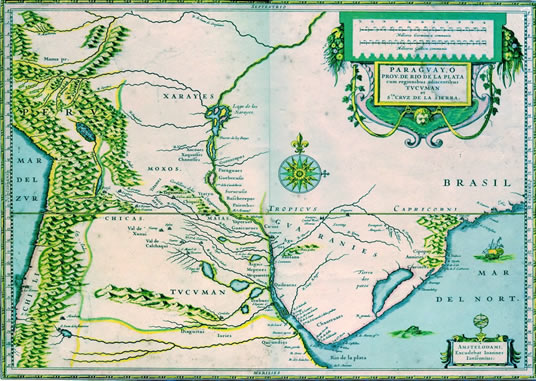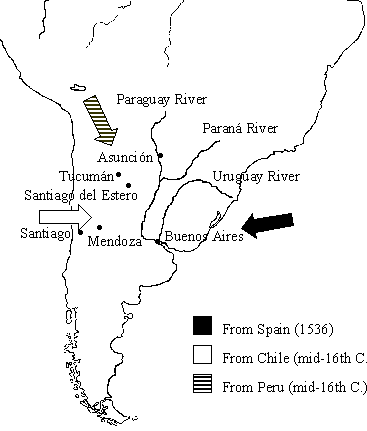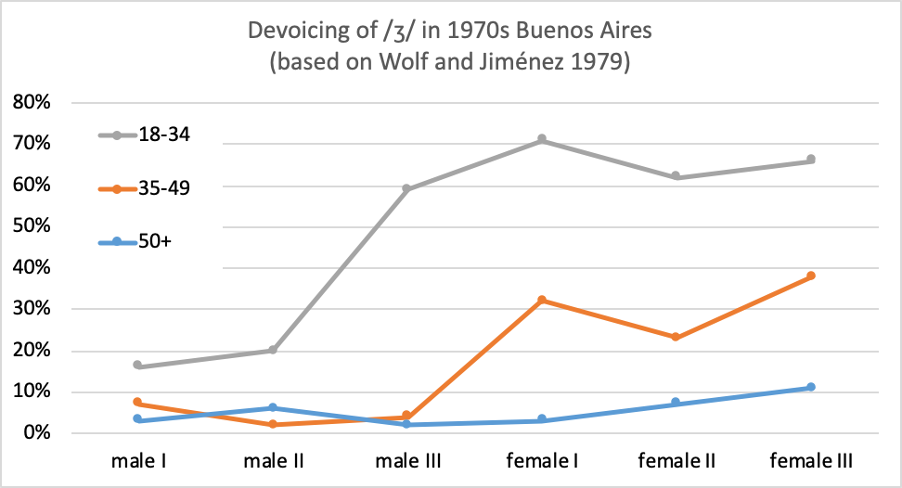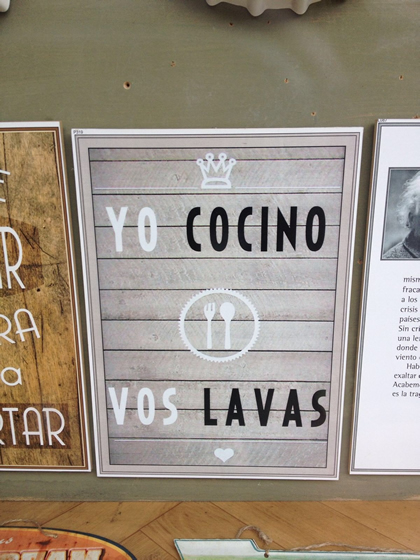1. Historical
Background
The area around
the Río de la Plata (the estuary formed by the convergence of the Paraná and
Uruguay rivers) is now one of the most densely populated in Latin America.Throughout much of the colonial period, however, it was an economic and
cultural backwater. With the prohibitionon direct trade across the Atlantic,
it was for centuries accessible only by an enormous overland journey down and
across the southern continent. The full importance of the area was only
acknowledged with the formation of the Viceroyalty of Río de la Plata in 1776,
comprising present-day Argentina, Uruguay, Paraguay and Bolivia. This
historical isolation from the centres of power, culture and education is
reflected in a variety of Spanish that has traditionally been characterized by
archaism and non-standard innovation.
The settlement of Argentina was carried out from three different points (see sketch map below to the right). In the first place, settlement of the area immediately around the Río de la Plata came directly from Spain, with the foundation of Buenos Aires in 1536 by the Andalusian Pedro de Mendoza. When hostile indigenous tribes from the Pampas forced the evacuation of Buenos Aires a few years later, the settlement was moved to Asunción, several hundred miles up the Paraná river. Asunción in turn served as the base for the re-establishment of Buenos Aires in 1580. Throughout the bulk of Argentina, excluding the northwest, the Cuyo region next to Chile and the Guaraní-speaking areas close to the northeastern border with Paraguay (Misiones, Corrientes, Resistencia and Formosa), Buenos Aires is regarded as the locus of the standard Argentine variety of Spanish.
Northwestern Argentina was settled from Peru, via Bolivia. Indeed the major city, Tucumán (established 1565), was under the jurisdiction of the Audencia of Charcas (Bolivia) right up until the establishment of the Viceroyalty of Río de la Plata in 1776. The Spanish of this area is best classified with the Andean varieties of the language, especially as this region once contained a significant Quechua-speaking population. Despite geographically belonging to northwestern Argentina, the city of Santiago del Estero (founded 1553) is a linguistic enclave with unique dialectal features. This is probably due to the fact that it was rapidly overshadowed by Córdoba and Tucumán, and so fell into a state of cultural and economic isolation, after having initially enjoyed direct trade routes with Lima.
Finally, the
Cuyo region in the extreme west was settled from Chile, with the cities of
Mendoza (founded 1561), San Juan (1562) and San Luis (1591-1594) remaining
under the jurisdiction of Chile until the creation of the Viceroyalty of Río de
la Plata nearly two centuries later. Today, the speech of this area still bears
a close resemblance to the Spanish of central Chile, although the status of the
Buenos Aires dialect as the national standard is beginning to be felt.
Uruguay, in contrast, has a much less elaborate history. Originally known as the Banda Oriental (the land to the east of the Uruguay river), it remained pretty much unsettled by Europeans until the Portuguese incursions from 1680 onwards. Montevideo was only established in 1726 (by Spaniards from Buenos Aires) and then only as a garrison designed as part of the effort to repel the Portuguese. From then on, the territory was fought over by Spaniards and Portuguese (later by Argentines and Brazilians), until in 1828 itwas established as an independent state, intended primarily to act as a ‘buffer’ between Argentina and Brazil.
About 70 per cent of the Uruguayan population lives in Montevideo, and much of the Spanish spoken in Uruguay can be regarded as an extension of the Buenos Aires dialect. Apart, that is, from the bilingual fronterizo speech that is to be encountered close to the border with Brazil, the legacy of a long history of settlement and annexation on the part of Uruguay’s Portuguese-speaking neighbour.
In the late 19th and early 20th centuries the arrival of tens of thousands of Italians in the Río de la Plata cities resulted in a major demographic shift, with residents of Italian origin accounting at the peak of the immigration for almost half the population of Buenos Aires and Montevideo. The Italo-Spanish interlanguage that flourished among Italian immigrants was known as cocoliche. Much caricatured in literature and on the stage, it came to occupy a prominent position in popular culture but has now more or less died out.
Canary Island immigration to the region in the 19th and 20th centuries was significant also (although the figures were never as high as in the Caribbean). Accordingly, it is not difficult to find items that belong to both ríoplatense and Canary speech, a case in point being the common words pibe ‘boy’ and piba ’girl’.
2. Pronunciation
Throughout Argentina (except the extreme west) and Uruguay the /ʝ/ (voiced palatal fricative) of general Latin American Spanish is replaced by a palato-alveolar fricative, a phenomenon known as rehilamiento. This palato-alveolar fricative was traditionally voiced, i.e. [ʒ], as found in French words like jouer ‘to play’ and rouge ‘red’. For example, the words ayer ‘yesterday’ and calle ‘street’ were typically pronounced as [aˈʒeɾ] and [ˈkaʒe] respectively, an articulation that attracts the label žeísmo. However, over the last four decades a voiceless variant, [ʃ], has become increasingly common, the words just mentioned tending more and more to be pronounced as [aˈʃeɾ] and [ˈkaʃe]. By analogy with the label žeísmo, this latter type of articulation is sometimes called sheísmo.
The voiceless sound [ʃ] now appears to be displacing voiced [ʒ] in Buenos Aires (Chang 2008), although outside the metropolitan area the trend towards devoicing appears to be less advanced and [ʒ]
may be still be the dominant variant. The advance of [ʃ] was foreshadowed in several studies in the 1970s, which found that sheísmo was a feature of the speech of many younger speakers, particularly young female speakers. This can be seen in the chart below, which is based on data from Wolf and Jiménez 1979 (the roman numerals on the horizontal axis refer to education: I = primary, II = secondary, III = tertiary).

Dialects which have žeísmo or sheísmo are usually also yeísta (i.e. orthographic ll and y correspond to the same sound). In the province of Santiago del Estero, however, in northwestern Argentina, ll and y are pronounced differently, but the distinction is not /ʎ/ ~ /ʝ/ as in Castile, Paraguay and the Andes. Rather, the distinction is between /ʒ/ and /ʝ/; thus [ˈkaʒe] calle ‘street’ but [aˈʝeɾ] ayer ‘yesterday’.
The other major areal feature is the weakening of syllable-final /s/, typically through debuccalization to [h], although the sibilant articulation is retained in parts of Santiago del Estero and in northwestern areas close to the Bolivian border. As elsewhere in the Spanish-speaking world, the pronunciation of syllable-final /s/ is a major sociolinguistic variable, the rate of weakening correlating inversely both with social class and with the formality of the speech situation.
3. Morphology
One of the most emblematic features of Argentine Spanish is voseo, which is the norm throughout the social spectrum. The associated verbal morphology, in the majority of the country (including Buenos Aires), is primarily of the assimilated type, although the present subjunctive and the future show a preference for verb forms borrowed from the tú paradigm. In the Cuyo region and in the far north-west, the relevant verbal morphology approximates to the Chilean pattern, which also includes dissimilated endings. And in the linguistically distinctive province of Santiago del Estero, a mixed pattern appears to be common, whereby the pronoun vos occurs with verb forms entirely from the tú paradigm: vos cantas, vos comes, vos vives etc.The standard Argentinian pattern, with less acceptable variants shown in parentheses, is summarized in Table 1 below:
Despite the
traditional preference for root-stressed present
subjunctive forms in the -ar and -er conjugations, there is some evidence (see Alvar 1996: 216) that the ending-stressed forms (cantés etc.) are viewed more positively by the younger generations, which opens up the
possibility that they constitute a paradigm that is undergoing sociolinguistic
promotion. 
The use of vos in Uruguay is not quite as entrenched as in Argentina. Thus tú predominates in several northern areas and in the southeastern corner of the country, while vos and tú compete in much of the intervening area. In Montevideo, the vos ~ tú alternation is a sociolinguistic variable, with many Uruguayans attaching low prestige to vos despite using it themselves. Such attitudes are reinforced in the prescriptive grammar taught in schools and one outcome of the ambivalent position of vos is that oxytone verb forms are frequently used with the pronoun tú, as in tú cantás, tú comés, tú vivís etc. Some scholars (Elizaincín 1981) even suggest that, in the present indicative, hybrid formulations of this kind represent the norm in educated Montevidean speech. Root-stressed verb forms carry more social prestige in the present subjunctive, however, although as in Buenos Aires and other cities in Argentina, ending-stressed forms (cantés, comás etc.) appear to be making inroads among the young.
The imperative endings that go with vos in Uruguay are the same as in Argentina. Usage in the preterite also parallels Argentina, as there is variation between endings with and without /-s/, the latter being the socially less prestigious of the two variants.
4. Syntax
The preterite is often used in ríoplatense Spanish where standard Spanish employs the perfect. Thus María no llegó could mean either ‘María has not arrived [yet]’ or ‘María did not arrive’.
The present subjunctive may be used in an embedded clause governed by a verb that is inflected for the preterite or the imperfect, as in (1) below. This is a context in which standard Spanish usually requires the past subjunctive:
(1) Quería que lo acompañemos.
Vernacular speech in many parts of the region exhibits a range of what might be called (non-technically) vulgarismos, some of which have been immortalized in the once flourishing Gaucho literary genre. For instance, a resumptive indirect object clitic may have a subject pronoun such as yo as its clitic left dislocated antecedent, as in example (2) below:
(2) Yo me parece que se rompió. (Cf. A mí me parece que se rompió.)
Other examples include the proclitic use of nos in the 1st person plural imperative (as in nos sentemos instead of standard sentémonos ‘let’s sit down’) and the use of se with a 2nd person plural verb form (as in se llevamos bien ‘we get along well’, se vamos ‘let’s go’).
One feature of rural Argentine dialects that may stem from the Canary inheritance is the placing of the subject of an infinitive before the verb rather than after it; e.g. al yo llegar instead of standard al llegar yo ‘when I arrive(d)’, de él saberlo instead of de saberlo él ‘if he knew’.
5. Lexicon
Leaving aside the lunfardo slang of Buenos Aires and Montevideo, Argentine and Uruguayan Spanish share much of their lexicon with the rest of the Southern Cone. Such items include pollera ‘skirt’, decir macanas ‘to talk nonsense’, playa ‘car park’, ambo ‘(two-piece) suit’. Many items exist, however, that are distinctively ríoplatense. The best-known of these is vocative che, which is so common in Argentina that residents of neighbouring countries refer to the Argentines as los che. Others include, canilla ‘tap’, pibe ‘boy’, piba ‘girl’ (both of likely Canary origin), añares ‘ages’ (as in Hace añares que . ’It’s ages since .’), cebador ‘choke (in car)’, copetín ’aperitif’, cortinado ‘curtains’, desquicio ‘chaos’, gramilla ’lawn’, pileta ‘swimming pool’, quilombo ‘mess/whorehouse’, sobre el pucho ‘straight away’, yerra ‘branding [with a hot iron]’, tilingo ’fussy/soft in the head’.
Turning now to lunfardo, the slang of the Buenos Aires and Montevidean working classes, typical items include: bacán ‘man!’, cafishio/cafisio ‘pimp’, cana ’police/prison’, falluto ‘boaster/hypocrite’, falopa ‘illicit drug’, fiaca ‘laziness’, minga ‘no/nothing’, farabute ’fool/wretch’, gil ‘fool’, menega ‘money’, manyar ‘to understand, know’, mina ‘woman/girlfriend’, micho ‘poor’, morfar ’to eat’, otario ‘fool’, sofaifa ‘man’. Lunfardo developed among the lowest social classes in Buenos Aires, from where it spread to Montevideo. In its original sense, ‘lunfardo’ was a term that was applied to thieves and pickpockets, a circumstance that has given rise to the popular (and probably erroneous) view that the lunfardo lexicon originated as a criminal jargon. Nowadays lunfardo has become a source of regionalistic pride, a development that has no doubt been assisted by its use in the lyrics of the Argentine tango.
6. Uruguayan/Brazilian
’Fronterizo’ Dialect
The northern Uruguayan departments of Artigas, Rivera, Cerro Largo, Salto and Tacuarembó were settled principally by Brazilians and form part of a territory that was the subject of a dispute with Brazil until 1861. The modern frontier with the Portuguese-speaking neighbour is about 1000 kilometres long and, until recently at least, it was unmanned. The linguistic result of this geopolitical indeterminacy is that there is no clear boundary line marking the point where Portuguese ends and Spanish begins. Rather, a continuum exists with the Portuguese of Rio Grande do Sul (the Brazilian state that borders Uruguay) at one end, Uruguayan Spanish at the other, and a spectrum of fronterizo dialects in between that gravitate in varying degrees towards either Portuguese or Spanish.
The best-studied city on the Uruguayan side is Rivera, which is right on the border. There the upper classes tend to be bilingual, employing Spanish or Portuguese as the situation demands. The lower classes, in contrast, tend to speak a hybrid fonterizo language that is best described as Hispanized Portuguese or Luso-Spanish (hence the popular designation portuñol). As one moves further into Uruguay, the fronterizo dialect acquires more of a Spanish character. ’
The main linguistic characteristics of fronterizo are the following. In terms of the pronunciation: (i) the vowel /a/ may be articulated in unstressed syllables as a schwa-like central unrounded vowel [ə], as in Portuguese; (ii) Portuguese-style nasal vowels may intrude into the system; (iii) the mid vowels /e/ and /o/ are normally raised to [i] and [u] in unstressed syllables, especially final syllables; (iv) the place of articulation of preconsonantal /s/ may be retracted to the palato-alveolar position, yielding voiceless [ʃ] or voiced [ʒ] depending on whether the following consonant is voiced or not. Some speakers may also affricate /t/ and /d/ to [tʃ] and [dʒ] before [i], as in [ˈdẽntʃi] ‘tooth’, although this is rare.
On the grammatical side, interference phenomena abound. For example, cognate suffixes from the two languages (e.g. Spanish -ón/Portuguese -ão, Spanish -ero/Portuguese -eiro) are likely to alternate with each other, as are those forms of the definite article that are phonologically similar across the two languages, viz. Spanish los, la and las and Portuguese os, a and as.
Finally, lexical mixing is all-pervasive, with Portuguese words like fechar ‘to close’ and janela ‘window’ routinely appearing in sentences composed primarily from Spanish lexical items. In this way, fronterizo is likely to have served as an entry point for some of the Brazilianisms that have come into general Uruguayan usage.
References
Alvar, Manuel (ed.). 1996. Manual de dialectología hispánica: el español de América. Barcelona: Ariel.
Chang, Charles. 2008. ‘Variation in palatal production in Buenos Aires Spanish.’ In Selected Proceedings of the 4th Workshop on Spanish Sociolinguistics, ed. Maurice Westmoreland and Juan Thomas (Somerville, Cascadilla), pp. 54–63.
Elizaincín, Adolfo. 1981. ‘Sobre tuteo/voseo en el español montevideano.’ In Estudios sobre el español del Uruguay, ed. Adolfo Elizaincín (Montevideo: Universidad de la República, Dirección General de Extensión Universitaria), pp. 81–86.
Wolf, Clara and Jiménez, E. 1979. ‘El ensordecimiento del yeísmo porteño, un cambio fonológico en marcha.’ In Estudios lingüísticos y dialectológicos: Temas hispánicos, ed. Ana María Barrenechea et al. (Buenos Aires: Hachette Universidad), pp. 115–135.